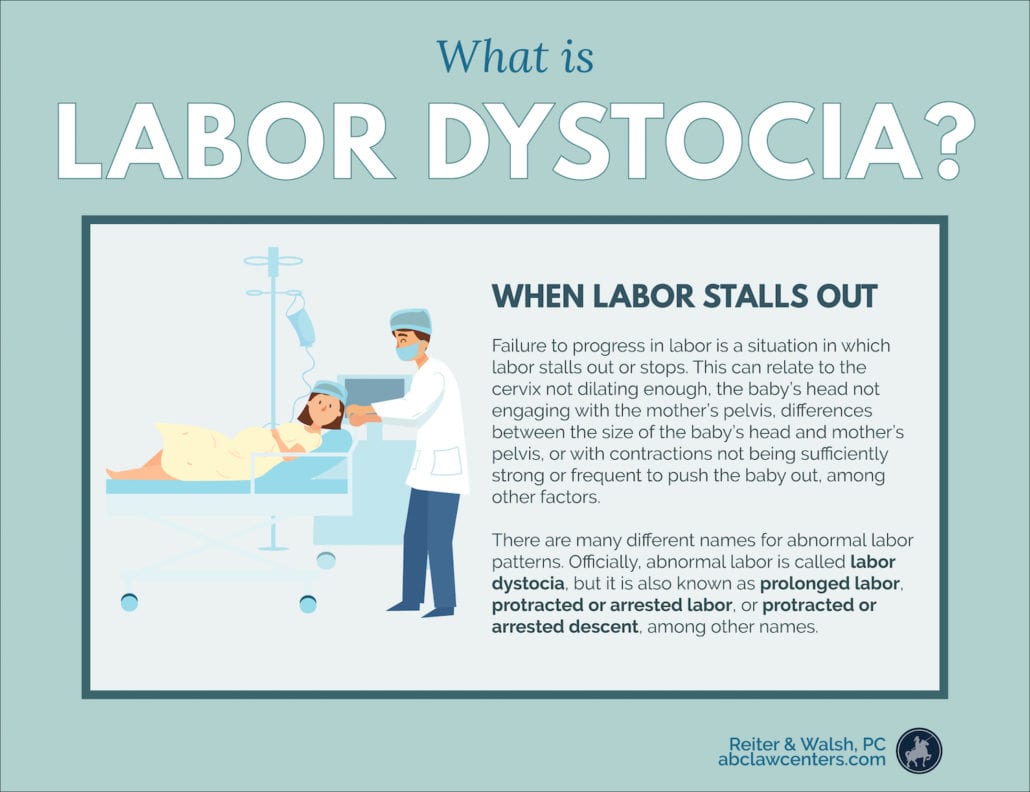Failure to Progess and Prolonged Phases of Labor
There is much debate in the obstetrics and gynecology communities regarding what is considered a ‘normal’ labor. One of the most influential labor curves, the Friedman curve, has been used for upwards of 50 years for helping OB/GYNs monitor the labor process and diagnose potential problems during different stages of labor. Recently, some researchers have supported revising the Friedman curve in favor of adopting a wait-and-see approach; this approach is highly controversial as it has the potential to increase rates of birth trauma.

What Does Labor Look Like?
The process of labor and delivery is divided into generally-recognized stages. Each of these stages has certain characteristics that can help evaluate whether labor is progressing normally. These stages include:
- First stage of labor: Begins at the onset of labor until the mother’s cervix is fully dilated
- Second stage of labor: Begins when the mother’s cervix is fully dilated until the baby is delivered
- Third stage of labor: Begins when the baby is delivered until the placenta is delivered
- Some researchers say there is a fourth stage of labor defined as the hour after the delivery of the placenta, but often this is lumped in with the third stage
What Is Failure to Progress in Labor?
Failure to progress in labor is a situation in which labor stalls out or stops. This can relate to the cervix not dilating enough, the baby’s head not engaging with the mother’s pelvis, differences between the size of the baby’s head and mother’s pelvis, or with contractions not being sufficiently strong or frequent to push the baby out, among other factors. There are many different names for abnormal labor patterns. Officially, abnormal labor is called ‘labor dystocia,’ but it is also known as ‘prolonged/protracted/arrested labor’ or ‘protracted or arrested descent,’ among other names.
Risk Factors for Failure to Progress in Labor
There are certain risk factors that make failure to progress in labor more likely, including:
- Premature rupture of membranes (PROM)
- Nulliparity (first-time mother)
- Labor induction
- Maternal age 35+
- Fetal weight 4kg+
- Hypertensive disorder
- Polyhydramnios
- Fertility treatments
- Ineffective uterine contractions
- Pelvic contractures
- Cephalopelvic disproportion (CPD)
- Fetal malposition or malpresentation
- Early use of analgesics
- Nerve block anesthesia (click here for more information on problems associated with analgesia/anesthesia)
- Anxiety and stress
Mapping Out What Labor Looks Like: How Labor Curves Establish Normal Labor
Medical professionals use labor curves to help them understand whether a labor is progressing well or if is stalled or arrested. One of the most thorough and comprehensive evaluations of labor was done by Emmanuel Friedman, resulting in the Friedman curve, a system that especially detailed the first stage of labor. This curve used data from thousands of births to help establish a baseline of what was considered a ‘normal’ labor. His curve specifically looked at women who:
- Delivered vaginally without induction
- Delivered babies with no congenital abnormalities
- Delivered at term with the baby in the vertex position
- Had normal-shaped pelvises
- Had no labor complications, cephalopelvic disproportion, fetal malposition or malpresentation
- Did not receive heavy sedation, conduction analgesia, or oxytocin
- Did not have operative intervention like forceps or vacuum extractors
Recent efforts have been made to revise the Friedman curve or throw it out altogether, replacing it with an untested curve by Zhang et al. (2002). The new curve allows medical professionals to continue waiting to diagnose a problem with labor, even in situations where labor has been stalled for hours. These new curve attempt to redefine a ‘new normal’ at the expense of the health of mothers and children.
What Is a Normal First Stage of Labor? What Is a Prolonged First Stage of Labor?
The Friedman curve divides the first stage of labor into two parts: the latent phase (which starts when regular uterine contractions set in and ends at the beginning of the active phase) and the active phase (which begins when rapid cervical dilation begins and ends when the mother’s cervix is fully dilated). The active phase begins around when the mother is about 3-4 cm dilated, though some controversial definitions place it at 6 cm.
What Is a Protracted or Dysfunctional Latent Phase of Labor?
According to the labor curve established by Dr. Emmanuel Friedman, a protracted or dysfunctional latent phase occurs when a mother experiences regular contractions that should cause cervical dilatation for more than 20 hours (for women who have not had a baby before), or 14 hours (for women who have). Long latent phases are associated with unfavorable outcomes for the baby, which include subsequent labor abnormalities, low Apgar scores, and the need for neonatal resuscitation. For the mother, an abnormally long latent phase is associated with a doubled risk of 3rd- and 4th degree lacerations, febrile lacerations, and intrapartum blood loss.
What Is a Protracted Active Phase of Labor?
After the latent phase, there is a transition to the active phase. According to Friedman, the typical length of the active phase is 2.5 hours; according to some rewritten and highly controversial definitions, this stretches to 5.5 hours. An abnormally long active phase could also signal a problem with labor. Issues with a prolonged active phase are subdivided into two different categories:
| Protraction Disorders | |
| When cervical dilation and descent of the fetal head are slower than normal throughout the process. Protraction disorders happen in instances of cephalopelvic disproportion (CPD), when conduction anesthesia is used, and when the baby is malpositioned. Oxytocin augmentation does not help correct protraction disorders in this situation. | |
| How are Protraction Disorders Diagnosed? | |
| In women who haven’t had a baby before: | In women who have had a baby before: |
| Cervical dilation ≤ 1.2cm/hrDescent of fetal head ≤ 1cm/hr | Cervical dilation ≤ 1.5cm/hrDescent of fetal head ≤ 2cm/hr |
| Arrest Disorders | |
| When cervical dilation and descent of the fetal head are initially normal but then stall out or stop progressing. | |
| How are Arrest Disorders Diagnosed? | |
| According to Friedman, arrested active phase of labor occurs if either cervical dilation stops for more than 2 hours or descent of the fetal head stops for more than 1 hour. Recent attempts have been made to revise this definition by some obstetrics groups, where arrest of labor can only be diagnosed in women with ruptured membranes with at least 6 cm of dilation after 4 hours (with adequate contractions) or after 6 hours (with inadequate contractions). This means that women who previously would have been diagnosed with a stalled labor are considered ‘normal’ under the new system. | |
What Is a Prolonged Deceleration Phase in Labor?
Some researchers find that there is a deceleration phase during active labor. The cervix dilates very quickly, but towards the end of the active phase, cervix dilation slows down. However, if a mother had a previously normal labor but then has a prolonged time to achieve full dilation, this could be a sign of a problem.
When there is a prolonged deceleration phase, progress in dilation slows after 8 cm and uterine contractions become dysfunctional, even after oxytocin administration. In this situation, the cervix starts to swell and take on fluid. In this situation, a C-section may be needed. In many cases where this happens, the underlying problem may be that the baby is in an abnormal position that can’t be delivered, or can’t fit through the mother’s pelvis.
Some medical professionals try to have the mother push through a contraction to try to fit the baby’s head through the cervix. The problem with this approach is that it ends up making cervical swelling worse. This maneuver can sometimes lead medical professionals to believe that the cervix is completely dilated when it is not and when the baby’s head hasn’t descended into the position needed for delivery. This ends up prolonging labor in a situation where a C-section would be required in the first place.
What Is a Normal Second Stage of Labor? What is a Prolonged Second Stage of Labor?
The second stage of labor begins when the cervix is completely dilated and ends when the baby is delivered. The median duration of the second stage of labor is about 50 minutes for women who haven’t had a baby before, and about 20 minutes for those who have. However, the length of the second stage of labor is highly variable (Kilpatrick, 1989). Some researchers define abnormal second stage of labor as a labor that has stalled when descent or rotation of the fetal head doesn’t occur after 7 cm of dilation. Arrested second stage of labor often occurs in the presence of shoulder dystocia.
What Is an Abnormal Third Stage of Labor?
An abnormal third stage of labor occurs when the placenta does not fully or properly separate from the uterus, placing the mother at high risk for massive maternal bleeding. This can occur in situations where the placenta is incompletely detached, or in situations where the mother has placenta accreta or percreta. There is much debate about placental management during the third stage of labor. Some obstetricians recommend manual removal or gentle massage to stimulate contractions. Another method generally recognized as safe is prophylactic uterotonic medication to reduce blood loss. In situations of placenta accreta or percreta, however, more aggressive management may be needed to stem the bleeding; this may include curettage or partial or complete hysterectomy. In rare cases, uterine inversion may occur in situations where mothers have had a fundal implantation; this situation requires prompt treatment to attempt to reinvert the uterus and prevent additional complications.
Management of Arrested Labor
The management of arrested labor is controversial. Friedman recommends C-section after 2 hours of arrested labor, while other researchers suggest waiting a minimum of 4 hours, with Pitocin (synthetic oxytocin) augmentation, before moving on to a C-section. The four-hour suggestion, however, puts babies at risk. If there is a situation in which the baby cannot fit through the birth canal, they are still experiencing strong contractions from Pitocin augmentation during that four hours while they are stuck. Not only does this ‘wait and see’ approach delay what would be an already-necessary C-section, but it would expose that baby to further risk of birth injury as the baby is subject to additional hours of chemically-augmented contractions. These contractions increase the risk of severe cranial compression as contractions force the baby’s head against the mother’s pelvis, and Pitocin-related hyperstimulation (also known as uterine tachysystole) may cause oxygen deprivation-related injuries as the placenta is unable to replenish its oxygen supply.
Summary: What Does Abnormal Labor Look Like?
The following chart quickly summarizes abnormal labor patterns:
| Abnormal Labor Patterns | ||
| Type | Duration (for those giving birth for the first time) | Duration (for those who have given birth before |
| Prolonged latent phase | >20 hr | >14hr |
| Protracted active phase dilation | <1.2cm/hr | <1.5cm/hr |
| Secondary arrest: no change | ≥2 hr | ≥2 hr |
| Protracted descent (ie protracted 2nd stage) | <1cm/hr | <2cm/hr |
| Arrest of descent | ≥1 hr | ≥30 min |
| Failure of descent | No change during deceleration stage and second stage | |
| Precipitous labor | >5cm/hr | 10cm/hr |
Labor and Delivery Attorneys | ABC Law Centers: Birth Injury Lawyers

The attorneys at ABC Law Centers: Birth Injury Lawyers focus solely on birth injury. Since its inception in 1997, the firm has been helping parents feel secure knowing that their children will be taken care of – no matter what. If you believe you child has developmental disabilities, cerebral palsy, or other delays due to a birth injury, we are available to speak with you anytime.